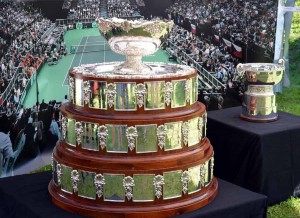by Randy Walker
@TennisPublisher
Now that the new Davis Cup format has been passed – whether you like it or not – it will begin to be implemented starting next year.
I wrote about how the hypothetical format would unfold earlier this summer here: http://www.worldtennismagazine.com/archives/15622 To expand and repeat what I originally wrote, there still needs to be some tweaks to the format, based on the information that has been released.
One of my suggested changes is that this event has to happen in September, and Gerard Pique, his Kosmos group and the International Tennis Federation have already started to make motions to have this change implemented. The most important element of this is that the teams that have to play in the first round “qualifying round” in February of the next year need more than just eight weeks to scout, select sites for home ties and to promote them. Players need more time to plan their schedules.
One item that I have a problem with – and will probably rear its ugly head very soon in the event as it is set-up now – is that the Davis Cup final features 18 teams in a round-robin format. This is made up of 12 teams that win the first-round home-and-away matches and the four semifinalists from the previous year as well as two “wild card” teams. What is the criteria for a wild card? Is this saved for a potential home-team based on where the competition is held? Is it saved for the highest monetary bidder? This is open for something not competitively fair, in my opinion, so I believe this should be scrapped. The number of teams in the final should be 16, not 18. The announced 18-team format will be divided in six three-team round-robin groups where they will play two matches featuring two singles and one doubles match in a best-of-three match series with matches being best-of-three sets. The winner of the six round-robin groups advance into a quarterfinal and will be joined by the two-best second-place teams in the round-robin groups. What is likely to happen is you are going to have a lot of teams with 1-1 round robin records, so what is the criteria for tiebreakers to determine who wins the round-robin group if all three teams have 1-1 records? Even more confusing will be how do you determine the two second-place teams that advance into the quarterfinals among the six round-robin groups when they all have the same record? Is it matches won? Sets lost? Most service games won? Some astute tennis officials and followers who I have spoken to just shook their heads in astonishment when presented with this.
The best format would be a 16-team round-robin with four groups of four, where more of a clear winner can be established. The four winners of each round-robin group would qualify for the semifinals – and just get rid of any second-place finishers qualifying. A nice rhythm of matches for the week – allowing for days off between matches – can be seen in my previous article here: http://www.worldtennismagazine.com/archives/15622
The winner each round-robin group – a clear accomplishment – would also be exempt from playing in the “first-round” the next year and would automatically qualify for the final the following year.
As I wrote earlier, a rule that can be considered is that the team that wins the Davis Cup gets the opportunity to host this 16-team final (notice I wrote “16-team final” and not “18-team final”) in their country, harkening back to the tradition (which is good to revert to with Davis Cup) of the old “Challenge Round” format where the winning team hosted the final – or Challenge Round – against the emerging challenging nation the following year. Should this nation not be able to host the event in one facility or in one city, it could, potentially, be held in two nearby cities, similar to World Cup soccer being played in multiple cities. Perhaps a rule could be implemented that says one nation may not host the 16-team Davis Cup final more than one time in a five-year period so as to open up the competition to one of the other three teams that reach the Davis Cup semifinals (and to guarantee that the event will have a “host” nation that will play in front of their own fans.) If a Davis Cup champion nation had hosted the 16-team Davis Cup final within five years, the runner-up nation would receive the nod to host the event and then if that nation had also hosted within five years, it would be offered to the semifinalists.
On Tennis Channel during the US Open, U.S. Davis Cup Captain Jim Courier suggested that the Davis Cup should be combined with the Fed Cup into a major two-week event, like the Grand Slam tournaments in excitement and revenues, and be turned into two-week extravaganza. An April date, after Indian Wells and the Miami Open, may be a sensible date, which is equidistant between the Australian and French Opens.

